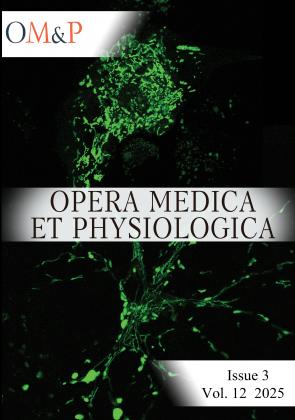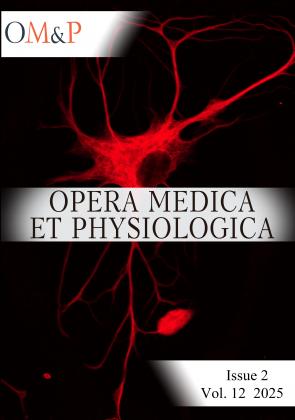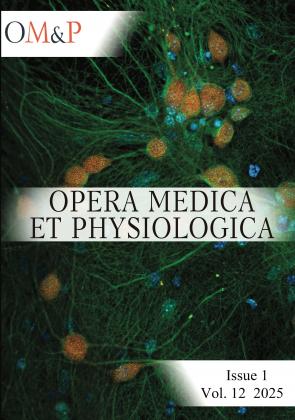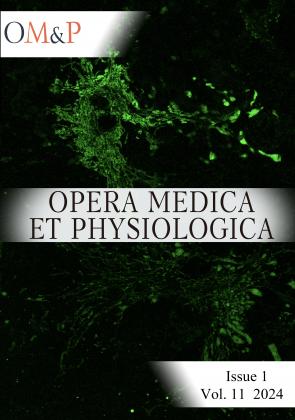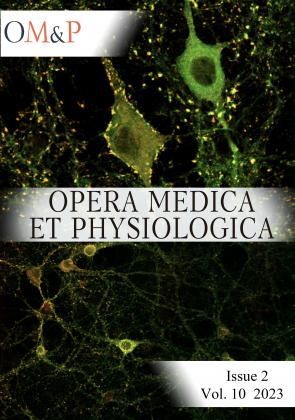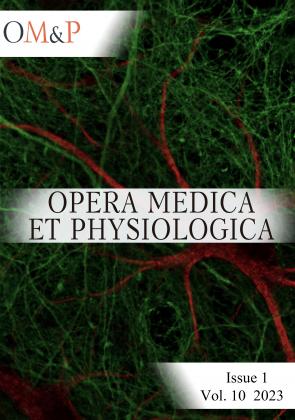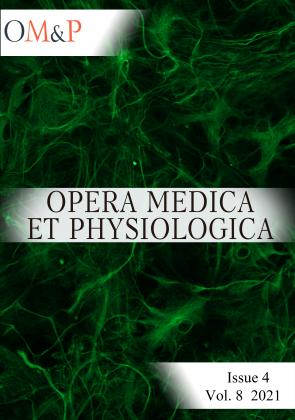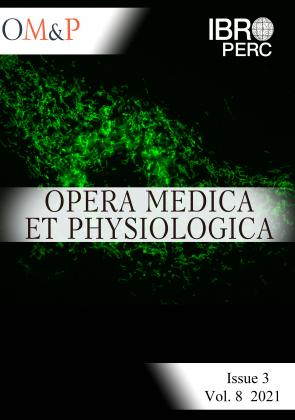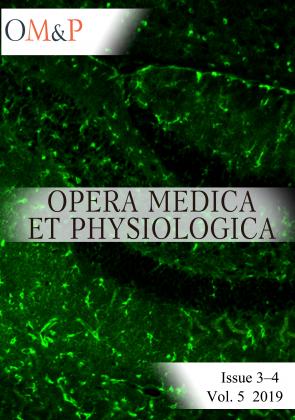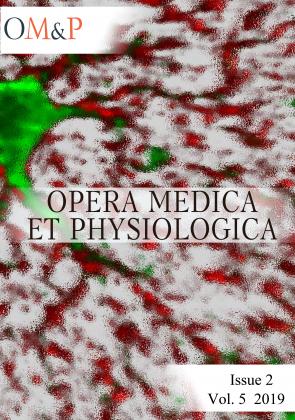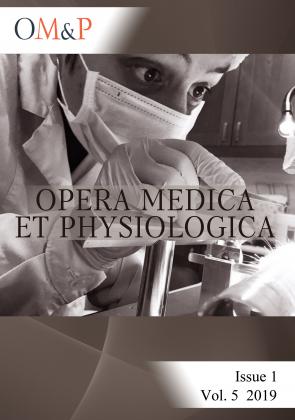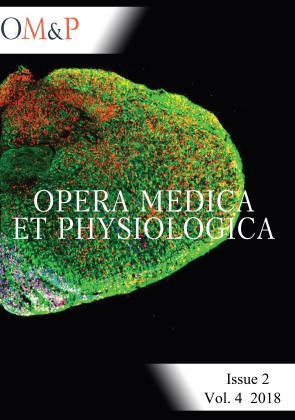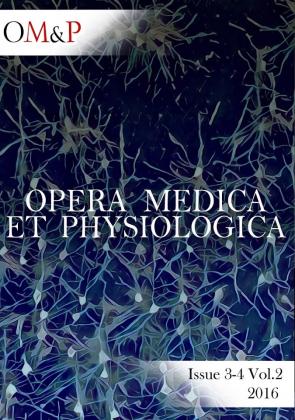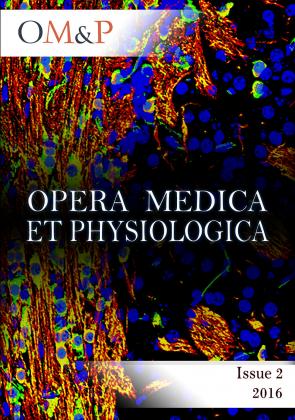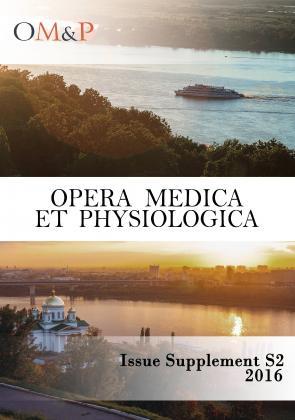Issue 3, 4 | December 2018
Full-length research paper
Published ahead of print December 10, 2018; Printed December 24, 2018; OM&P 2018 Volume 4 Issue 3, 4, pages 97-99
Abstract
Full Text
For many decades synaptic circuits have been associated solely with cell-cell neuronal connections represented by the presynaptic terminal, which releases a neurotransmitter, and the postsynaptic neuronal specialization, a site where the neurotransmitter can activate synaptic receptors. However, due to technical limitations these studies usually were linked only to the postsynaptic site. For a long while, the widespread techniques that rapidly advanced neurophysiology have been little used in understanding the way how Ca2+-dependent release of the excitatory neurotransmitter glutamate from neuronal axons can be measured directly. Only with the advance of live cell imaging, it became possible to detect internal Ca2+ dynamics in presynaptic boutons with the high temporal resolution.
Full-length research paper
Published ahead of print December 10, 2018; Printed December 24, 2018; OM&P 2018 Volume 4 Issue 3, 4, pages 78-85; doi:10.20388/omp2018.003.0061
Abstract
Full Text
Issue 2 | September 2018
Full-length research paper
Published ahead of print September 18, 2018; Printed September 30, 2018; OM&P 2018 Volume 4 Issue 2, pages 71-77; doi:10.20388/omp2018.001.0057
Abstract
Full Text
Parkinson's disease is a progressive age-associated neurological disorder. One of the major neuropathological hallmarks of Parkinson’s disease is the appearance of protein aggregates, mainly consisting of the protein alpha-Synuclein. These aggregates have been described both in genetic as well as idiopathic forms of the disease. Currently, Parkinson’s disease patient-specific induced pluripotent stem cells (iPSCs) are mainly used for in vitro disease modeling or for experimental cell replacement approaches. Here, we demonstrate that these cells can be used for in vivo disease modeling. We show that Parkinson’s disease patient-specific, iPSC-derived neurons carrying the LRRK2-G2019S mutation show an upregulation of alpha-Synuclein after transplantation in the mouse brain. However, further investigations indicate that the increased human alpha-Synuclein levels fail to induce spreading or aggregation in the mouse brain. We therefore conclude that grafting of these cells into the mouse brain is suitable for cell autonomous in vivo disease modeling but has strong limitations beyond that. Furthermore, our results support the hypothesis that there might be a species barrier between human to mouse concerning alpha-Synuclein spreading.
Full-length research paper
Published ahead of print September 17, 2018; Printed September 30, 2018; OM&P 2018 Volume 4 Issue 2, pages 63-70; doi:10.20388/omp2018.001.0058
Abstract
Full Text
The convoluted human cerebral cortex is one of the key features that allows for an increased neuronal density packing essential for the complex cognitive and socioemotional behaviours man possesses. Nevertheless, the underlying mechanisms involved in cortical folding remained a both intriguing and functionally important enigma. A crucial component known to be involved in the formation and maintenance of all tissues is the extracellular matrix (ECM), providing scaffolds which tie tissues and organs in place. The composition of the ECM in both developing and mature structures is constantly remodelled, degraded and secreted by numerous types of cells, and its role as a source of growth factors and signalling in morphogenesis, migration, and proliferation is increasingly appreciated. Evidence for the differential expression of ECM during gyrification pinpoints its potentially fundamental role in shaping the folds of the cerebral cortex through both mechanical and molecular configurations. This review aims at addressing key ideas, potential directions and discoveries that highlight biomechanics of the ECM during the construction of the cortex cerebral gyrification.
Full-length research paper
Published ahead of print September 16, 2018; Printed September 30, 2018; OM&P 2018 Volume 4 Issue 2, pages 50-62; doi:10.20388/omp2018.001.0059
Abstract
Full Text
Vocalization is a highly conserved innate behavior in vertebrates. It is mainly used in social encounters to communicate a variety of information for inter- and intra- specific interactions. In this review, we focus on the anatomical, biomechanics and neuronal circuits underlying vocalization across vertebrate species. In addition, we discuss our recent findings that assign to the nucleus of the solitary tract a critical role in innate vocalization. This brain center receives viscerosensory information, i.e. information from internal organs that includes the lungs and the larynx. Furthermore, subpopulations of neurons in the nucleus of the solitary tract directly connect to and entrain the activity of expiratory and laryngeal motor neurons. In mammals and amphibians, these motor neurons control essential biomechanical parameters used for vocalization, and similar motor neuron pools regulate vocal utterances in birds. Thus vocalization relies on a conserved neuronal circuit residing in the brainstem and spinal cord.
Full-length research paper
Published ahead of print September 15, 2018; Printed September 30, 2018; OM&P 2018 Volume 4 Issue 2, pages 35-49; doi:10.20388/omp2018.002.0056
Abstract
Full Text
The present study was performed to determine the behavioral effects of cholecalciferol (Vitamin D3) hormone treatment at different doses as an adjunctive therapy alone or in a combination with low dose of 17β-estradiol on depression-like behavior of female rats after long-term absence of estrogen. The aim of the study was to examine the effects of chronic cholecalciferol administration (1.0, 2.5 or 5.0 mg/kg/day, SC once daily, for 14 days) on depression-like behavior following long-term ovariectomy (12 weeks) of the adult (3 months old) female rats of Wistar line. Cholecalciferol was administered to the ovariectomized (OVX) rats and OVX rats treated with low dose of 17β-estradiol (17β-E2, 0.5 μg/rat, SC once daily, for 14 days) after long-term ovariectomy. Depression-like behavior was assessed in the forced swimming test (FST), locomotor and grooming activities were assessed in the open field test (OFT). Using biochemical studies were evaluated estradiol and 25-hydroxyvitamin D3 levels in the blood serum of OVX rats treated with cholecalciferol alone and cholecalciferol plus 17β-E2. Chronic administration of cholecalciferol (5.0 mg/kg/day, SC) into the intact females significantly reduced depression-like behavior in the FST (p<0.05). The treatment with cholecalciferol (1.0 mg/kg/day, SC) in the OVX rats after long-term absence of estrogens induced antidepressant-like effect (p<0.05) in the FST. Moreover, cholecalciferol in this dose plus 17β-E2 more markedly exhibited antidepressant-like effect in the OVX rats after longterm ovariectomy (p<0.05). Simultaneously, treatment with cholecalciferol (1.0 mg/kg/day, SC) in the OVX rats after longterm absence of estrogens produced elevated estradiol and 25-OH-VD3 levels for the OVX rats as compared to the OVX females. The combined application of cholecalciferol (2.5 and 5.0 mg/kg/day, SC) and 17β-E2 produced antidepressantlike effect that was similar to the antidepressant-like effect of 17β-E2. Our results indicate that cholecalciferol at dose of 5.0 mg/kg/day induced antidepressant-like effect only in intact rats subjected FST. Following long-term ovariectomy in the adult female rats, cholecalciferol at dose of 1.0 mg/kg/day administered alone resulted in decrease of depression-like behavior in the FST. Moreover, cholecalciferol at dose of 1.0 mg/kg/day in a combination with 17β-E2 at a low dose induced synergic antidepressant-like effect in the FST.
Supplement S 1 | June 2018
Published ahead of print June 02, 2018; Printed June 30, 2018; OM&P 2018 Volume 4 Supplement S 1, pages 102-110; doi:10.20388/omp2018.00s1.006
Abstract
Full Text
Published ahead of print June 02, 2018; Printed June 30, 2018; OM&P 2018 Volume 4 Supplement S 1, pages 85-101; doi:10.20388/omp2018.00s1.005
Abstract
Full Text
Published ahead of print June 02, 2018; Printed June 30, 2018; OM&P 2018 Volume 4 Supplement S 1, pages 71-84; doi:10.20388/omp2018.00s1.004
Abstract
Full Text
Published ahead of print June 02, 2018; Printed June 30, 2018; OM&P 2018 Volume 4 Supplement S 1, pages 38-70; doi:10.20388/omp2018.00s1.003
Abstract
Full Text
Published ahead of print June 02, 2018; Printed June 30, 2018; OM&P 2018 Volume 4 Supplement S 1, pages 35-37; doi:10.20388/omp2018.00s1.002
Abstract
Full Text
Published ahead of print June 02, 2018; Printed June 30, 2018; OM&P 2018 Volume 4 Supplement S 1, pages 1-34; doi:10.20388/omp2018.00s1.001
Abstract
Full Text
Issue 1 | March 2018
Published ahead of print April 02, 2018; Printed March 29, 2018; OM&P 2018 Volume 4 Issue 1, pages 1-18; doi:10.20388/omp2018.001.0053
Abstract
Full Text
Ionic homeostasis in the brain involves redistribution of ionic fluxes in several cell types and compartments, including neurons, astrocytes and the extracellular space. How the major ionic activity-dependent fluxes of potassium and sodium are individually regulated remains difficult to dissociate and to track experimentally. We here review recent progress in modeling the ionic fluxes evoked by neuronal activity based on mass conservation. Excitability of neurons indeed relies on inward sodium and outward potassium fluxes during action potential firing. Recently, we have developed a tri-compartment model based on mass-action kinetics equations that account for potassium dynamics between neurons, astrocytes and the extracellular space. This review describes how such type of model can be used to spatially and temporally predict potassium fluxes during various regimes of neuronal activity. In particular, the model initially showed that it takes several seconds for astrocytes to buffer the majority of the potassium rapidly released by neurons in both basal and high regime of activity. Such model can also probe the selective contribution of ionic channels, and revealed for instance that disruption of the main astroglial potassium Kir4.1 channels not only favors the emergence of epileptiform activity, but also dysregulates neuronal excitability specifically during slow rhythmic activities. We here also extend the predictions of the model by assessing the selective contribution of the astroglial and neuronal Na/K ATPase, or volume of the extracellular space on potassium dynamics. We discuss these findings and their implications for neuronal information processing in the healthy and diseased brain.
Published ahead of print March 29, 2018; Printed March 29, 2018; OM&P 2018 Volume 4 Issue 1, pages 23-34; doi:10.20388/omp2018.001.0055
Abstract
Full Text
The goal of the work was to study the effect of the cannabinoid receptor agonist WIN55,212-2 and the cannabinoid type 1 receptor antagonist AM251 on electrophysiological changes in the hippocampus and the medial septal region (MS) induced by the intracerebral administration of excitotoxin kainic acid. Kainate injected into the right brain ventricle provoked persistent seizures (status epilepticus, SE) in all rats. A morphological analysis of the right hippocampus performed one month after the SE revealed the death of neurons, which was most pronounced in the hilus of the dentate gyrus and in the CA3a field of the dorsal hippocampus. In brain slices taken one month after the SE, the spontaneous activity of MS neurons and population EPSP (pEPSP) in the CA1 field of the hippocampus evoked by the stimulation of Shaffer collaterals (SC) was recorded; the changes in the activity were compared with the activity in slices of healthy animals injected with normal saline (“control slices”). It was found that the activity in MS slices from the brain of animals injected with kainic acid (“kainate slices”) was almost twice higher than in the control. After the application of WIN55,212-2, the frequency of discharges in the control did not change, whereas in kainate slices, the level of neuronal activity decreased to the control value. The application of AM251 led to an increase in the frequency of discharges in the control and its decrease in kainate slices. The registration of pEPSPs in the hippocampal slices revealed a twofold increase in the responses to SC stimulation in kainate slices compared with those in the control, i.e., an abrupt increase in neuronal excitability. A tendency for a decrease in excitability after the application of WIN55,212-2 and, conversely, for its increase by the action of AM251 was noted in evoked responses in the hippocampal kainate slices. Our results allow to assume the protective impact of cannabinoid agonist WIN55,212-2 on neuronal activity in the medial septum and hippocampus that disturbed by neurotoxic kainate influence.
Published ahead of print March 29, 2018; Printed March 29, 2018; OM&P 2018 Volume 4 Issue 1, pages 19-22; doi:10.20388/omp2018.001.0054
Abstract
Full Text
Сlassical bioindicators – amphibians – were used to assess the quality of the environment and detect cytogenetic disorders. There are immature erythrocytes with rounded micronuclei in the bone marrow cells. The merging and transformation of micronuclei occurs in the process of mitotic division and erythrocytes maturing. It leads to a prepotency in the bloodstream of erythrocytes with disintegrated micronuclei and an attached micronucleus. An integrated research study of the environment using the cytogenetic characteristics of living organisms is called for.
Issue 3, 4 | December 2017
Published ahead of print December 28, 2017; Printed December 25, 2017; OM&P 2017 Volume 3 Issue 3, 4, pages 93-98; doi:10.20388/omp2017.003.0050
Abstract
Full Text
Synchrony in neuronal networks plays a crucial role in the functioning of the brain. Stability of synchrony is most desirable to prevent any emergent desynchrony due to natural events, internal or external disturbances. The brain might have its own mechanism to repair its desynchrony, otherwise, some external procedure might be necessary to restore synchrony. We propose here a mechanism to realize robust synchrony in neuronal networks against parameter drifting. A selective addition of cross-coupling links over and above the conventional diffusive coupling links is found [Saha et al. (2017)] recently that makes dramatic improvements in the stability of synchrony of dynamical networks and that saves synchrony against breakdown due to parameter drifting. We apply the concept to realize globally stable synchrony in neuronal networks and the desired effect of robust synchrony and, present our numerical studies with examples of network motifs and a larger network of neurons and using the Hindmarsh-Rose (HR) [Hindmarsh and Rose (1984)] slow-fast neuron model for each node of the networks.
Published ahead of print December 27, 2017; Printed December 25, 2017; OM&P 2017 Volume 3 Issue 3, 4, pages 84-92; doi:10.20388/omp2017.003.0049
Abstract
Full Text
This review focuses on temperature dependence of biophysical properties of ion channels of other than TRP types. Some functional consequences of the channels temperature sensitivity for neuronal excitation in health and disease are considered.
Published ahead of print December 18, 2017; Printed December 25, 2017; OM&P 2017 Volume 3 Issue 3, 4, pages 99-107; doi:10.20388/omp2017.003.0052
Abstract
Full Text
Neurons of the substantia nigra are most prone to degeneration in Parkinson’s disease. The cause of their vulnerability remains unclear and knowledge of the molecular and microstructural features of the substantia nigra pars compacta will help understanding why nigral neurons are vulnerable to damaging factors.
The present study was aimed to investigate the intranuclear inclusions of the nigral neurons, the Marinesco bodies and the Roncoroni rodlets, which origin and function are uncertain, using ubiquitin-, tyrosine hydroxylase-, nitric oxide synthase-, calbindin-, NeuN-, glutamic acid decarboxylase-, and α-tubulin-immunohistochemistry and iron histochemistry with DAB enhancement.
Of the tested substances, tyrosine hydroxylase and nitric oxide synthase were revealed for the first time in the Marinesco bodies. Non-heme iron was found for the first time in both the Marinesco bodies and the Roncoroni rodlets. In accordance with previous studies, ubiquitin-immunoreactivity was demonstrated in the Marinesco bodies. Moreover, we describe some smaller round and dot-like ubiquitin-immunoreactive structures in the nucleus of melanized neurons. The found small ubiquitin-immunopositive structures within the nucleus are proposed to be the developmental stages of growing Marinesco bodies, whereas Marinesco bodies themselves seem to label the neurons with impaired function of proteasome.
Published ahead of print December 18, 2017; Printed December 25, 2017; OM&P 2017 Volume 3 Issue 3, 4, pages 71-83; doi:10.20388/omp2017.003.0048
Abstract
Full Text
Recurrent epileptiform activity induces network sodium oscillations in the juvenile hippocampus. In CA1 pyramidal neurons, these oscillations are mainly caused by opening of glutamate-gated ion channels, while in astrocytes, sodium increases are due to sodium-dependent glutamate uptake. Astrocytes express the glutamate transporters GLAST and GLT- 1, which exhibit differential expression patterns during postnatal development. The specific contribution of these transporter subtypes to sodium oscillations is not known. We addressed this question by performing somatic sodium imaging in hippocampal tissue slices from neonatal (postnatal days (P) 2-4) and two-week-old (P14-16) mice. We found that perfusion with Mg2+-free, bicuculline-containing saline caused sodium oscillations in both developmental stages. Moreover, at both P2-4 and P14-16, application of TFB-TBOA to inhibit GLAST and GLT-1 generated fast sodium loading of neurons and termination of oscillatory activity, accompanied by loss of membrane integrity of neurons, while astrocytes experienced only minor increases in baseline sodium. DHK, a GLT-1-specific blocker, induced moderate sodium loading of neurons, reduced the amplitude of neuronal sodium oscillations and increased the oscillation frequency in two-week-old mice. In neonatal animals, DHK increased baseline sodium and reduced the peak amplitude of sodium transients as well, but exerted only moderate effects on network activity. Taken together, our experiments demonstrate the essential role of glutamate uptake for sodium homeostasis and neural function already in the early neonatal brain. Moreover, they suggest that, although GLAST dominates in neonatal tissue and GLT-1 is predominant at P14-16, both transporter subtypes functionally contribute to glutamate clearance during the first three weeks after birth.
Published ahead of print December 18, 2017; Printed December 25, 2017; OM&P 2017 Volume 3 Issue 3, 4, pages 59-70; doi:10.20388/omp2017.003.0051
Abstract
Full Text
The aim of the current study was to examine the effects of chronic cholecalciferol administration (1.0, 2.5 or 5.0 mg/kg/day, s.c., once daily, for 14 days) on the anxiety-like and depression-like behaviors following long-term ovariectomy (12 weeks) in female rats. Cholecalciferol was administered to the ovariectomized (OVX) rats and OVX rats treated with 17β-estradiol after long-term absence of estrogen (17β-E2, 0.5 µg/rat, s.c., once daily, for 14 days). Anxiety-like behavior was assessed in the elevated plus maze (EPM), depression-like behavior was assessed in the forced swimming test (FST), locomotor and grooming activities were assessed in the open field test (OFT). The treatment with cholecalciferol (1.0 mg/kg/day, s.c.) in the OVX rats after long-term absence of estrogens induced antidepressant-like effect (p<0.05). Moreover, cholecalciferol in this dose plus 17β-E2 more markedly exhibited antidepressant-like effect in the OVX rats after long-term ovariectomy (p<0.05). The OVX rats treated with cholecalciferol at doses of 1.0 mg/kg and 2.5 mg/kg demonstrated a decrease of anxiety-like behavior in the EPM. The combination of cholecalciferol at doses of 1.0 and 2.5 mg/kg with a low dose of 17β-E2 more effectively decreases anxiety-like behavior in the OVX rats after long-term estrogen deficiency than17β-E2 alone. This work promotes more effective creation of novel therapeutic targets and strategies for affective-related disorders treatment in female subjects with long-term estrogen deficiency.
Supplement S 1 | September 2017
Symposium
Published ahead of print September 13, 2017; Printed September 15, 2017; OM&P 2017 Volume 3 Supplement S 1, pages 1-15; doi:10.20388/omp2017.00s1.001
Abstract
Full Text
Published ahead of print September 13, 2017; Printed September 15, 2017; OM&P 2017 Volume 3 Supplement S 1, pages 16
Abstract
Full Text
Issue 2 | June 2017
Published ahead of print July 16, 2017; Printed June 30, 2017; OM&P 2017 Volume 3 Issue 2, pages 48-58; doi:10.20388/omp2017.002.0045
Abstract
Full Text
The rapid advance of super-resolution microscopy and its experimental applications has provided neuroscientists with a pass to the nanoscopic world of synaptic machinery. Here we will briefly overview and discuss current progress in our understanding of the three-dimensional synaptic architecture and molecular organisation as gleaned from the imaging methods that go beyond the diffraction limit of conventional light microscopy. We will argue that such methods are to take our knowledge of synapses to a qualitatively new level, providing the neuroscience research community with novel organising principles and concepts pertinent to the workings of the brain.
Published ahead of print June 19, 2017; Printed June 30, 2017; OM&P 2017 Volume 3 Issue 2, pages 39-47; doi:10.20388/omp2017.002.0047
Abstract
Full Text
The aim of the present study was to explore the effects of 8-OH-DPAT, 5-HT1A receptor agonist and NAN-190, 5-HT1A receptor antagonist on anxiety-related behavior in the adult gonadectomized (GDX) male rats. Moreover, another goal of this work was to investigate whether the combination of 8-OH-DPAT or NAN-190 plus testosterone propionate (TP) could affect anxiety-like behavior more than TP alone in the adult GDX rats. Two weeks after gonadectomy, GDX rats were subjected by treatments with the solvent, TP (0.5 mg/kg, s.c.), 8-OH-DPAT (0.05 mg/kg, s.c.), NAN-190 (0.1 mg/kg, i.p.), 8-OH-DPAT in a combination with TP or NAN-190 in a combination with TP during 14 days. Experimental groups of GDX rats and control group of intact males were then tested in the elevated plus maze (EPM) and the open field test. 8-OH-DPAT treatment failed to modify anxiety-like behavior of GDX rats in the EPM as compared to the GDX rats given with oil solvent. NAN-190 injected alone or in combination with TP to GDX rats resulted in a significant anxiolytic-like effect as compared to the GDX given with oil solvent or TP application. Our data indicate that the combination of NAN-190 and TP is more effective than TP alone in GDX rats inducing a more profound anxiolytic-like effect in the EPM. Thus, the results of this study suggest that effects of 5-HT1A receptor agonist/antagonist can modify anxiety level in opposite direction in male rats after gonadectomy.
Published ahead of print June 18, 2017; Printed June 30, 2017; OM&P 2017 Volume 3 Issue 2, pages 31-38; doi:10.20388/omp2017.002.0046
Abstract
Full Text
Nitric oxide (NO) signalling contributes to many biological processes involved in activity-dependent fine tuning of neuronal communication. NO is involved in early developmental signalling of the nervous system and is associated with pathological pathways and age-related decline in neuronal function, thus playing a critical role in regulating neuronal function in physiology and disease. Here we assessed the effects of modulating endogenous neuronal nitric oxide synthase (NOS) activity on synaptic function, specifically on neurotransmitter release at the glutamatergic Drosophila neuromuscular junction (NMJ). We found that the absence of NOS activity enhanced synaptic release at the NMJ and conversely, overexpression of NOS diminished transmitter release. The effects of alterations in NO signalling are the consequence of acute signalling at the synapse as we did not observe any developmental changes in NMJ morphology or synaptic parameters, such as expression of the active zone protein, bruchpilot, which could account for changes in release. Ultrastructural analysis did not show any developmental effects in boutons from larvae with reduced NOS activity. Together, our data present evidence for a negative regulation of transmitter release by NO which has implications for physiological synaptic function but also pathological and age-related dysregulation of synaptic signalling.
Issue 1 | March 2017
Published ahead of print April 11, 2017; Printed March 31, 2017; OM&P 2017 Volume 3 Issue 1, pages 1-13; doi:10.20388/omp2017.001.0041
Abstract
Full Text
The role of chaos in biological information processing has been established as an important breakthrough of nonlinear dynamics, after the early pioneering work of J.S. Nicolis and notably in neuroscience by the work of Walter J. Freeman and co-workers spanning more than three decades. In this work we revisit the subject and we further focus on novel results that reveal its underlying logical structure when faced with the cognition of ambiguous stimuli. We demonstrate, by utilizing a minimal model for apprehension and judgement related to Bayesian updating, that the fundamental characteristics of a biological processor obey in this case an extended, non-Boolean, logic which is characterized as a quantum logic. And we realize that in its essence the role of chaos in biological information processing accounts for, and is fully compatible with, the logic of “quantum cognition” in psychology and neuroscience.
Published ahead of print April 11, 2017; Printed March 31, 2017; OM&P 2017 Volume 3 Issue 1, pages 19-24; doi:10.20388/omp2017.001.0042
Abstract
Full Text
Understanding the molecular and cellular processes that cause dementia is one of the most important challenges in neuroscience. SUMOylation is a post-translational protein modification that has been strongly implicated in neurodegenerative diseases. To investigate SUMOylation in dementia we profiled the expression of key SUMOylation pathway proteins in post mortem brain tissue from Alzheimer’s Disease (AD) and Down’s Syndrome (DS) patients. As expected, both AD and DS tissue displayed massively increased levels of phosphorylated tau compared to age- and sex-matched controls. Surprisingly, there were no changes in the levels of the E1 and E2 enzymes required for protein SUMOylation, or in levels of the deSUMOylating enzyme SENP1. There was, however, a marked decrease in the SUMO-2/3-specific deSUMOylating enzyme SENP3 in DS. There were also increased levels of SUMO-1 conjugated proteins in DS, but not in AD tissue. While these results do not exclude roles for SUMOylation in AD, they demonstrate clear differences in the profile of SUMOylation and in the expression of deSUMOylating enzymes between AD and DS brain.
Published ahead of print April 11, 2017; Printed March 31, 2017; OM&P 2017 Volume 3 Issue 1, pages 25-29; doi:10.20388/omp2017.001.0044
Abstract
Full Text
Ulcerative colitis is a chronic inflammatory disease of the gastrointestinal system, affecting adults and children. Its cause is unknown, and the knowledge of reliable biomarkers is limited, especially for children. That makes the search for new biomarkers and pushing forth the analysis of the available data particularly challenging. We investigate proteomic data from children patients as a promising source, and tackle the problem implementing the recently developed parenclitic network approach to machine learning algorithms that solve classification task for proteomic data from healthy and diseased. We expect our approach to be applicable to other gastrointestinal diseases.
Published ahead of print March 29, 2017; Printed March 31, 2017; OM&P 2017 Volume 3 Issue 1, pages 14-18; doi:10.20388/omp2017.001.0043
Abstract
Full Text
A spatially stable pattern of two coexisting coherent and incoherent subpopulations in nonlocally coupled dynamical systems is called as chimera states and seen in many paradigmatic limit cycle as well as chaotic models where the coupling interaction is basically diffusive type. In neuronal networks, besides diffusive electrotonic communication via gap junctions, chemical transmission occurs between the pre-synapse and post-synapse of neurons. We consider, in a numerical study, a network of neurons in a ring using the Hindmarsh-Rose (HR) bursting model for each node of the network and, apply attractive gap junctions for local coupling between the nearest neighbors and inhibitory nonlocal coupling via chemical synaptic transmission between the distant neighbors. For a range of gap junctional and chemical synaptic coupling strengths, a subpopulation of the neuronal network, in the ring, bursts asynchronously and another subpopulation remains silent in a synchronous state. The bursting subpopulation of neurons fires sequentially along the ring when the number of firing nodes remains same but change their positions periodically in time. It appears as a traveling chimera pattern in the ring when the dynamics of the individual bursting nodes is chaotic. The chimera pattern travels in a reverse direction for a larger chemical synaptic coupling strength. A purely inhibitory chemical synaptic coupling can produce a similar traveling chimera pattern, however, the dynamics of the firing nodes is then periodic.
Issue 3, 4 | December 2016
Published ahead of print December 20, 2016; Printed December 25, 2016; OM&P 2016 Volume 2 Issue 3, 4, pages 173-176; doi:10.20388/omp2016.003.0036
Abstract
Full Text
Given the recent findings on the importance of CD38 signaling in the pathogenesis of colon cancer. We hypothesized that single nucleotide polymorphisms (SNP) in the CD38 gene may be related to colon cancer risk. CD38 has a genetic polymorphism, characterized by a C>G variation in the regulatory region of intron 1. The working hypothesis is that the presence of different alleles in colon cancer patients accounts for some of the clinical heterogeneity. CD38 is considered a marker of prognosis and as an indicator the activation and proliferation of cells. We hypothesized that single nucleotide polymorphisms (SNP) in the CD38 gene may be related to colon cancer risk. We evaluated one potentially functional CD38 SNP, intronic rs6449182 in two cases patients and controls. Genotyping was done using PCR-based assays in a total of 93 patients with colon cancer and 100 controls. We found that frequencies of variant allele (rs6449182 G) were significantly higher in colon cancer. Logistic regression analysis revealed an association between colon cancer and genotypes: rs6449182 CC [odds ratio (OR), 0.57; 95% confidence interval (95% CI), 0.32 – 1.01], rs6449182 CG (OR, 1.47; 95% CI, 0.83 – 2.60), and rs6449182 GG (OR, 2.26; 95% CI, 0.66 – 7.77). We observed that rs6449182 G carriers had more advanced clinical stage (P = 0.04). In conclusion, our data show that CD38 SNP may affect CD38 expression and contribute to the increased risk of colon cancer carcinogenesis.
Published ahead of print December 19, 2016; Printed December 25, 2016; OM&P 2016 Volume 2 Issue 3, 4, pages 177-180; doi:10.20388/omp2016.003.0037
Abstract
Full Text
The assembly of neural circuits during development endows the brain with the ability to perceive the environment, control motor output, and perform higher cognitive functions. Failure to assemble proper neural circuits may result in neurodevelopmental disorders including intellectual disability and autism spectrum disorders. Epigenetic mechanisms, and in particular chromatin remodeling, are potent regulators of neuronal connectivity. Here, we review recent studies highlighting the essential role of the ATPdependent nucleosomal remodeling and deacetylase (NuRD) complex in epigenetic programming of neurons to drive neural circuit assembly and organism behavior.
Published ahead of print December 18, 2016; Printed December 25, 2016; OM&P 2016 Volume 2 Issue 3, 4, pages 181-187; doi:10.20388/omp2016.003.0040
Abstract
Full Text
Isolated brain tumors contain cells that exhibit stem cell features and a tissue microenvironment bearing remarkable similarities to the normal neurogenic niche. This supports the idea that neural stem (NSCs) or progenitor cells, and their progeny are the likely tumor cell(s) of origin. This prompted the investigation of the relationship between NSCs/progenitors and the initiation of tumorigenesis. These studies led to the identification of common signaling machineries underlying NSC development and tumor formation, particularly those with known roles in proliferation and cell fate determination. This review will explore the molecular mechanisms that regulate NSC behavior in the neurogenic niche of the forebrain, and how deregulation of the developmental potential of NSCs might contribute to tumorigenesis.
Published ahead of print December 17, 2016; Printed December 25, 2016; OM&P 2016 Volume 2 Issue 3, 4, pages 188-204; doi:10.20388/OMP.003.0034
Abstract
Full Text
Neurons adapt to stimuli through activity dependent changes to their transcriptome, a process mediated by immediate-early gene networks. Recent findings that transcriptional activation of neuronal immediate-early genes requires the formation of controlled DNA double-strand breaks (DSBs) has come as a surprise and has profound implications for neuronal function, especially in the aging brain. Here we review recent literature surrounding the phenomena of activity-dependent DNA DSBs in neurons and how this process may be exploited by transposable elements (TEs) in both naïve and aging neurons. We hypothesize the existence of Activity DEPendent Transposition (ADEPT), where neuronal excitation is able to induce genomic rearrangements through either de novo integration of TEs or by homology-directed recombination of TE-derived repetitive sequences. Epigenetic drift may cause the magnitude of ADEPT to increase with age, leading to genome instability, which we suggest presages most, if not all, neurodegenerative diseases.
Published ahead of print December 16, 2016; Printed December 25, 2016; OM&P 2016 Volume 2 Issue 3, 4, pages 205-210; doi:10.20388/omp2016.003.0039
Abstract
Full Text
The presynaptic modifications that accompany long-term changes in synaptic plasticity are still not fully understood. Synaptophysin is a major synaptic vesicle protein involved in neurotransmitter release. We have used quantitative electron microscopy to study synaptophysin (Syn) immunolabelling in the hippocampus of adult rats 24h after induction in vivo of long term potentiation (LTP), and long term depression (LTD). Electrodes were implanted chronically in hippocampus with stimulation at either the medial (MPP) or lateral perforant path (LPP). 24h following induction of LTP or LTD rats were rapidly perfusion fixed and hippocampal tissue processed to electron microscopy via freeze substitution method. Anti-synaptophysin post-embedding immunolabelling was performed and tissue was imaged in the middle molecular layer (MML) of the dentate gyrus. There was a significant decrease in number of Syn labelled vesicles per unit area of bouton after LTP, but not LTD. An analysis of the spatial distribution of Syn labelled synaptic vesicles showed an increase in nearest neighbour distances, more so in the LTP than the LTD group, which is consistent with the overall decrease of Syn after LTP. These data are in agreement with the suggestion that Syn is involved in clathrin-dependent and “kiss and run” endocytosis which occurs perisynaptically. Thus, an increase in release of neurotransmitter and in consequence endocytosis would be consistent with an increased active zone distance for vesicles containing Syn.
Published ahead of print December 15, 2016; Printed December 25, 2016; OM&P 2016 Volume 2 Issue 3, 4, pages 211-227; doi:10.20388/ OMP.003.0035
Abstract
Full Text
Neural prostheses (NPs) link the brain to external devices, with an eventual goal of recovery of motor and sensory functions to patients with neurological conditions. Over the past half-century, NPs have advanced significantly from the early ideas that sounded like science fiction to the modern high-tech implementations. In particular, invasive recordings using multichannel implants have enabled real-time control of artificial limbs by nonhuman primates and human subjects. Furthermore, NPs can provide artificial sensory feedback, allowing users to perceive the movements of prosthetic limbs and their haptic interaction with external objects. Recently, NP approach was used to build brain-nets that enable information exchange between individual brains and execution of cooperative tasks. This review focuses on invasive NPs for sensorimotor functions.
Published ahead of print December 14, 2016; Printed December 25, 2016; OM&P 2016 Volume 2 Issue 3, 4, pages 228-234; doi:10.20388/omp2016.003.0038
Abstract
Full Text
We revisit the Wendling-Chauvel neural mass model by reducing it to eight ODEs and adding a dierential equation that accounts for a dynamic evolution of the slow inhibitory synaptic gain. This allows to generate dynamic transitions in the resulting nine-dimensional model. The output of the extended model can be related to EEG patterns observed during epileptic seizure, in particular isolated pre-ictal spikes and low-voltage fast oscillations at seizure onset. We analyse the extended model using basic tools from slow-fast dynamical systems theory and relate the main transitions towards seizure states to torus canards, a type of solutions that has been shown to explain the spiking to bursting transition in many neural models. We nd that the original ten-dimensional Wendling-Chauvel model can be reduced to eight dimensions, two variables being scaled versions of two other variables of the model. We then obtain a model with four PSP blocks, which is consistent with the block-diagrams typically presented to describe this model. Instead of varying the slow inhibitory synaptic gain parameter B quasi-statically, or just performing numerical bifurcation analysis in B as the structure of the fast subsystem of an hypothetical extended system, we construct a true slow dynamics for B, depending sensitively on the main PSP output of the model, Y0. Near fold bifurcation of limit cycles of the original model, the solution to the extended model performs fast low-amplitude oscillations close to both attracting and repelling branches of limit cycles, which is the signature of a torus canard phenomenon.
Issue 2 | July 2016
Published ahead of print July 10, 2016; Printed July 23, 2016; OM&P 2016 Volume 2 Issue 2, pages 87-102; doi:10.20388/OMP2016.002.0026
Abstract
Full Text
Glycogen synthase kinase 3 (GSK-3) is an important molecular player involved into diverse cellular functions including metabolism, transcription, cell survival and synaptic plasticity. Here, we focused on characterization of the cognitive effects of GSK-3 inhibitor, a newly developed compound VP3.36. In particular, we assessed VP3.36 effects on working memory, episodic memory, executive functioning, spatial learning & memory and fear memory. VP3.36 (3 mg/kg) significantly enhanced working memory and spatial object recognition in C57BL/6J mice. The GSK-3 inhibitor was able to speed up solving obstacles given to experimental animals in the Puzzle test, thereby improving their executive functions. Lastly, VP3.36-treated mice learnt faster to find the escape platform in the Morris’ water maze and exhibited better spatial long-term memory than vehicle-treated animals. At the same time, GSK-3 inhibition did not affect fear memories, sensorimotor gating, emotional behavior or ambulation, suggesting that GSK-3 inhibition underlies specific cognitive processes, which are likely coupled with certain mechanisms of synaptic plasticity. Given that GSK-3 inhibition has clear effect on long-term depression (LTD), and the functional role of LTD in brain is still far from complete understanding, next, we probed effects of VP3.36 on synaptic LTD in the hippocampal CA1 subregion. We found that incubation of hippocampal slices with VP3.36 sufficiently prevented synaptic LTD, further supporting implication of GSK-3 into mechanisms of synaptic plasticity. Taken together, VP3.36 facilitated working memory, spatial episodic and long-term memory, enhanced executive functions in parallel with its ability to prevent synaptic LTD. Overall, our experiments showed implication of GSK-3 into mechanisms of synaptic plasticity and certain cognitive functions which help to deeper understand fundamental molecular-cellular mechanisms of cognitive enhancement’s processes.
Published ahead of print July 09, 2016; Printed July 23, 2016; OM&P 2016 Volume 2 Issue 2, pages 103-111; doi:10.20388/OMP2016.002.0027
Abstract
Full Text
Matrix metalloproteinase 9, MMP-9 is an extracellularly operating enzyme that has been demonstrated as an important regulatory molecule in control of synaptic plasticity, learning and memory. Either genetic or pharmacological inhibition of MMP-9 impairs late phase of long-term potentiation at various pathways, as well as appetitive and spatial memory formation, although aversive learning remains apparently intact in MMP-9 KO mice. MMP-9 is locally translated and released from the excitatory synapses in response to neuronal activity. Extrasynaptic MMP-9 is required for growth and maturation of the dendritic spines to accumulate and immobilize AMPA receptors, making the excitatory synapses more efficacious. Animal studies have implicated MMP-9 in such neuropsychiatric conditions, as e.g., epileptogenesis, autism spectrum disorders, development of addiction, and depression. In humans, MMP-9 appears to contribute to epilepsy, alcohol addiction, Fragile X Syndrome, schizophrenia and bipolar disorder. In aggregate, all those conditions may be considered as relying on alterations of dendritic spines/excitatory synapses and thus understanding the role played by MMP-9 in the synaptic plasticity may allow to elucidate the underpinnings of major neuropsychiatric disorders.
Published ahead of print July 08, 2016; Printed July 23, 2016; OM&P 2016 Volume 2 Issue 2, pages 112-116; doi:10.20388/OMP2016.002.0033
Abstract
Full Text
We propose a new approach for the quantitative characterization of cognitive human brain activity during visual perception. According to the theoretical background we analyze human electro-encephalograms (EEG) obtained while the subjects observe ambiguous images. We found that the decision-making process is characterized by specific oscillatory patterns in the multi-channel EEG data.
Published ahead of print July 07, 2016; Printed July 23, 2016; OM&P 2016 Volume 2 Issue 2, pages 117-121; doi:10.20388/OMP2016.002.0032
Abstract
Full Text
This review focuses on general optogenetics issues (in particular the choice of the necessary light exposure settings), as well as certain promising areas of research with optogenetics.
Published ahead of print July 06, 2016; Printed July 23, 2016; OM&P 2016 Volume 2 Issue 2, pages 122-140; doi:10.20388/OMP2016.002.0029
Abstract
Full Text
Astrocytes perform fundamental housekeeping functions in the central nervous system and through bidirectional communication with neurons are thought to coordinate synaptic transmission and plasticity. They are also renowned actors in brain pathology. Reactive gliosis and neuroinflammation are featured by many (if not all) acute and chronic neurodegenerative pathologies including Alzheimer’s disease (AD). The Ca2+/calmodulin-activated phosphatase calcineurin (CaN) plays a central role in the pathology-related changes of astroglial cells mainly through activation of the inflammation-related transcription factors Nuclear Factor of Activated T-cells (NFAT) and Nuclear Factor kB (NF-kB). In this contribution we focus on the mechanistic aspects of CaN signalling in astrocytes. We analyze the astroglial Ca2+ signalling toolkit in the context of Ca2+ signals necessary for CaN activation and focus on the astroglial CaN signalling through its direct target, NFAT, as well as the intricate relationships between CaN and NF-kB activation pathways.The majority of data about CaN-mediated signalling in astrocytes point to the role for CaN in pathology-related conditions while very little is currently known about signalling and function of astroglial CaN in physiology.
Published ahead of print July 05, 2016; Printed July 23, 2016; OM&P 2016 Volume 2 Issue 2, pages 141-152; doi:10.20388/OMP2016.002.0028
Abstract
Full Text
Maintenance of genome stability in the face of DNA damage is essential for cellular homeostasis and prevention of cancer and brain degeneration. The DNA damage response (DDR) is a complex response that is rapidly activated when a DNA lesion occurs in chromosomal DNA. Mutations affecting the proteins involved in the DDR can lead to genomic instability syndromes that involve tissue degeneration, cancer predisposition, premature aging, and brain mal-development and degeneration. Mutation of the kinase ATM leads to a prototype genomic instability syndrome, ataxia-telangiectasia (A-T). A-T is characterized by progressive cerebellar degeneration, immunodeficiency, genome instability, premature aging, gonadal dysgenesis, extreme radiosensitivity, and high incidence of lymphoreticular malignancies. One of the most devastating symptoms of A-T — cerebellar ataxia — develops progressively into general motor dysfunction. Based on our previous studies we hypothesized that the neurological deficits in genomic instability disorders stem (at least in part) from significant reduction in functionality of glial cells. We further hypothesized that impaired vascularization affects the environment in which the neurons and glial cells function, thereby reducing neuronal cell functionality. We found that ATM deficiency led to aberrant astrocytic morphology and alterations of vasculature both in cerebellum and the visual system. Moreover, we found reduced myelin basic protein immunoreactivity and signs of inflammation in ATM-deficient cerebella and optic nerve. Interestingly, similar findings have been reported in patients with other genomic instability disorders. These observations bolster the notion that astrocyte-specific pathologies and hampered vascularization and astrocyte-neuron interactions in the CNS play crucial roles in the etiology of genome instability brain disorders and underlie brain degeneration at specific sites.
Published ahead of print July 04, 2016; Printed July 23, 2016; OM&P 2016 Volume 2 Issue 2, pages 153-163; doi:10.20388/OMP2016.002.0030
Abstract
Full Text
The name astroglia unifies many non-excitable neural cells that act as primary homeostatic cells in the nervous system. Neuronal activity triggers multiple homeostatic responses of astroglia that include increase in metabolic activity and synthesis of neuronal preferred energy substrate lactate, clearance of neurotransmitters and buffering of extracellular K+ ions to name but a few. Many (if not all) of astroglial homeostatic responses are controlled by dynamic changes in the cytoplasmic concentration of two cations, Ca2+ and Na+. Intracellular concentration of these ions is tightly controlled by several transporters and can be rapidly affected by activation of respective fluxes through ionic channels or ion exchangers. Here we provide a comprehensive review of astroglial Ca2+ and Na+ signalling.
Published ahead of print July 03, 2016; Printed July 23, 2016; OM&P 2016 Volume 2 Issue 2, pages 164-171; doi:10.20388/OMP2016.002.0031
Abstract
Full Text
Thyroid hormones (THs) are essential for the development and function of the central nervous system (CNS), not only for neuronal cells but also for glial development and differentiation. In adult CNS, both hypo- and hyper-thyroidism may affect psychological condition and potentially increase the risk of cognitive impairment and neurodegeneration including Alzheimer’s disease (AD). We have reported non-genomic effects of tri-iodothyronine (T3) on microglial functions and its signaling in vitro (MORI et al., 2015). Here we report the effects of hyperthyroidism on glial cells in vivo using young and old male and female mice. Immunohistochemical analyses showed glial activation are sex- and age-dependent. We also injected fluorescent-labeled amyloid β peptide (Aβ1-42) intracranially to L-thyroxine (T4)–injected hyperthyroid model mice and observed sex-dependent microglial phagocytosis in vivo as well. These results may partly explain the gender- and age-dependent differences in neurological and psychological symptoms of thyroid dysfunction.
Supplement S 2 | June 2016
Published ahead of print June 29, 2016; Printed June 30, 2016; OM&P 2016 Volume 2 Supplement S 2, pages 1-17; doi:10.20388/OMP2016.00S2.001
Abstract
Full Text
Published ahead of print June 29, 2016; Printed June 30, 2016; OM&P 2016 Volume 2 Supplement S 2, pages 18-34; doi:10.20388/OMP2016.00S2.002
Abstract
Full Text
Published ahead of print June 28, 2016; Printed June 30, 2016; OM&P 2016 Volume 2 Supplement S 2, pages 35-50; doi:10.20388/OMP2016.00S2.003
Abstract
Full Text
Published ahead of print June 28, 2016; Printed June 30, 2016; OM&P 2016 Volume 2 Supplement S 2, pages 51-63; doi:10.20388/OMP2016.00S2.004
Abstract
Full Text
Published ahead of print June 28, 2016; Printed June 30, 2016; OM&P 2016 Volume 2 Supplement S 2, pages 64-80; doi:10.20388/OMP2016.00S2.005
Abstract
Full Text
Published ahead of print June 28, 2016; Printed June 30, 2016; OM&P 2016 Volume 2 Supplement S 2, pages 81-114; doi:10.20388/OMP2016.00S2.006
Abstract
Full Text

